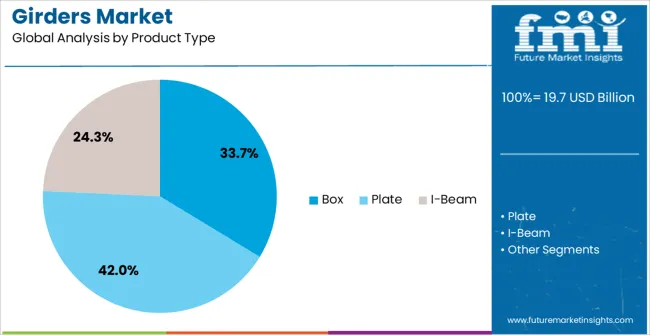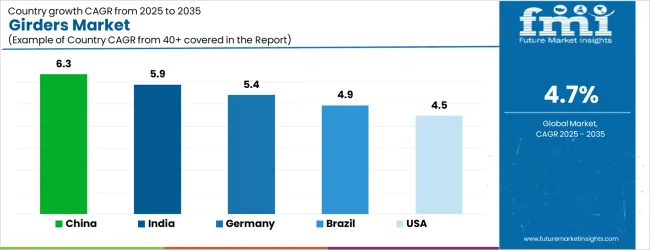The Girders Market is estimated to be valued at USD 19.7 billion in 2025 and is projected to reach USD 31.2 billion by 2035, registering a compound annual growth rate (CAGR) of 4.7% over the forecast period.


| Metric | Value |
|---|---|
| Girders Market Estimated Value in (2025 E) | USD 19.7 billion |
| Girders Market Forecast Value in (2035 F) | USD 31.2 billion |
| Forecast CAGR (2025 to 2035) | 4.7% |
The Girders market is experiencing steady growth, driven by the increasing demand for durable and high-performance structural components in bridge and building construction. Rising infrastructure investments, particularly in transportation networks and urban development projects, are supporting adoption of high-quality girders. Advancements in material science, design optimization, and fabrication processes have enhanced load-bearing capacity, corrosion resistance, and overall structural integrity.
Steel girders, in particular, are favored due to their high strength-to-weight ratio, versatility, and long service life. Growing emphasis on cost-effective and efficient construction solutions, along with stringent safety and regulatory standards, is further accelerating market expansion. Integration of modern design software and prefabrication techniques enables faster installation and reduced labor costs, contributing to project efficiency.
The increasing prevalence of large-scale bridge and highway projects, combined with a focus on sustainable construction practices, is expected to sustain market growth As urbanization and infrastructure modernization continue globally, the demand for high-performance girders is projected to rise steadily over the forecast period.
The girders market is segmented by materials, product type, bridge type, configuration type, length, and geographic regions. By materials, girders market is divided into Steel, Concrete, and Iron. In terms of product type, girders market is classified into Box, Plate, and I-Beam. Based on bridge type, girders market is segmented into Simple Beam, Arch Bridge, Suspension Bridge, Cable Stayed, and Cantilever Bridge. By configuration type, girders market is segmented into Top Running, Double Girder, Single Girder, and Under Running. By length, girders market is segmented into 10-20 K, Below 10 K, and More Than 20 K. Regionally, the girders industry is classified into North America, Latin America, Western Europe, Eastern Europe, Balkan & Baltic Countries, Russia & Belarus, Central Asia, East Asia, South Asia & Pacific, and the Middle East & Africa.

The steel materials segment is projected to hold 38.6% of the market revenue in 2025, establishing it as the leading material type. Growth in this segment is being driven by steel’s superior strength, durability, and adaptability in construction projects, making it suitable for bridges, high-rise buildings, and industrial structures. Steel girders provide high load-bearing capacity while maintaining a manageable weight, which reduces structural stress and foundation costs.
The material’s recyclability and corrosion-resistant properties further enhance its sustainability and long-term appeal. Modern fabrication techniques, including rolling, welding, and modular construction, enable faster production and assembly, supporting large-scale infrastructure projects.
The combination of performance, reliability, and cost-effectiveness has reinforced steel’s dominance in the market With ongoing urbanization, increased public infrastructure investments, and the need for durable construction materials, the steel segment is expected to retain its leading position and continue driving growth in the girders market.

The box product type segment is anticipated to account for 33.7% of the market revenue in 2025, making it the leading product type. Its growth is supported by superior structural efficiency, high torsional resistance, and flexibility in spanning long distances, which are critical for bridge and building applications. Box girders offer advantages in both load distribution and design adaptability, allowing engineers to optimize construction while reducing material usage.
The modular nature of box girders facilitates easier fabrication, transportation, and installation, improving project timelines and cost efficiency. Rising investments in modern bridges, elevated highways, and urban infrastructure have increased demand for box girder designs.
Their ability to support heavy loads and accommodate complex architectural requirements has reinforced their adoption in large-scale construction projects As infrastructure projects continue to expand globally, the box product type segment is expected to maintain its market leadership, driven by performance advantages, design versatility, and ongoing engineering innovations.

The simple beam bridge type segment is projected to hold 30.4% of the market revenue in 2025, establishing it as the leading bridge type. Growth is being driven by its ease of design, cost-effectiveness, and suitability for short to medium span bridges. Simple beam bridges require fewer resources and allow faster construction compared with more complex bridge types, making them ideal for highway, railway, and pedestrian applications.
The structural simplicity reduces engineering and maintenance complexity, which lowers long-term operational costs. Steel and box girders are often integrated into simple beam designs to enhance load-bearing capacity, durability, and safety.
Increasing investment in road and transportation infrastructure in both urban and rural regions is further supporting adoption As demand for reliable, efficient, and scalable bridge solutions continues to rise, the simple beam bridge type segment is expected to maintain its leading position, driven by a combination of practicality, cost efficiency, and widespread engineering acceptance.
Strong resurgence of the global construction industry and rapid technological advancements in manufacturing processes and material combinations are expected to be some of the primary factors that will contribute positively to the growth of the global girders market during the forecast period. The improved properties of most modern girders such as enhanced ductility, seismic resistance, strength, and easy fabrication are also anticipated to help the girders market grow.

| Country | CAGR |
|---|---|
| China | 6.3% |
| India | 5.9% |
| Germany | 5.4% |
| Brazil | 4.9% |
| USA | 4.5% |
| UK | 4.0% |
| Japan | 3.5% |
The Girders Market is expected to register a CAGR of 4.7% during the forecast period, exhibiting varied country level momentum. China leads with the highest CAGR of 6.3%, followed by India at 5.9%. Developed markets such as Germany, France, and the UK continue to expand steadily, while the USA is likely to grow at consistent rates. Japan posts the lowest CAGR at 3.5%, yet still underscores a broadly positive trajectory for the global Girders Market. In 2024, Germany held a dominant revenue in the Western Europe market and is expected to grow with a CAGR of 5.4%. The USA Girders Market is estimated to be valued at USD 7.1 billion in 2025 and is anticipated to reach a valuation of USD 7.1 billion by 2035. Sales are projected to rise at a CAGR of 0.0% over the forecast period between 2025 and 2035. While Japan and South Korea markets are estimated to be valued at USD 930.0 million and USD 658.1 million respectively in 2025.

| Item | Value |
|---|---|
| Quantitative Units | USD 19.7 Billion |
| Materials | Steel, Concrete, and Iron |
| Product Type | Box, Plate, and I-Beam |
| Bridge Type | Simple Beam, Arch Bridge, Suspension Bridge, Cable Stayed, and Cantilever Bridge |
| Configuration Type | Top Running, Double Girder, Single Girder, and Under Running |
| Length | 10-20 K, Below 10 K, and More Than 20 K |
| Regions Covered | North America, Europe, Asia-Pacific, Latin America, Middle East & Africa |
| Country Covered | United States, Canada, Germany, France, United Kingdom, China, Japan, India, Brazil, South Africa |
| Key Companies Profiled | ArcelorMittal, Nippon Steel Corporation, Tata Steel Limited, POSCO, China Baowu Steel Group Corporation Limited, JFE Steel Corporation, Thyssenkrupp AG, Nucor Corporation, Gerdau S.A., Hyundai Steel Company, JSW Steel Limited, United States Steel Corporation, and Voestalpine AG |
The global girders market is estimated to be valued at USD 19.7 billion in 2025.
The market size for the girders market is projected to reach USD 31.2 billion by 2035.
The girders market is expected to grow at a 4.7% CAGR between 2025 and 2035.
The key product types in girders market are steel, concrete and iron.
In terms of product type, box segment to command 33.7% share in the girders market in 2025.






Our Research Products

The "Full Research Suite" delivers actionable market intel, deep dives on markets or technologies, so clients act faster, cut risk, and unlock growth.

The Leaderboard benchmarks and ranks top vendors, classifying them as Established Leaders, Leading Challengers, or Disruptors & Challengers.

Locates where complements amplify value and substitutes erode it, forecasting net impact by horizon

We deliver granular, decision-grade intel: market sizing, 5-year forecasts, pricing, adoption, usage, revenue, and operational KPIs—plus competitor tracking, regulation, and value chains—across 60 countries broadly.

Spot the shifts before they hit your P&L. We track inflection points, adoption curves, pricing moves, and ecosystem plays to show where demand is heading, why it is changing, and what to do next across high-growth markets and disruptive tech

Real-time reads of user behavior. We track shifting priorities, perceptions of today’s and next-gen services, and provider experience, then pace how fast tech moves from trial to adoption, blending buyer, consumer, and channel inputs with social signals (#WhySwitch, #UX).

Partner with our analyst team to build a custom report designed around your business priorities. From analysing market trends to assessing competitors or crafting bespoke datasets, we tailor insights to your needs.
Supplier Intelligence
Discovery & Profiling
Capacity & Footprint
Performance & Risk
Compliance & Governance
Commercial Readiness
Who Supplies Whom
Scorecards & Shortlists
Playbooks & Docs
Category Intelligence
Definition & Scope
Demand & Use Cases
Cost Drivers
Market Structure
Supply Chain Map
Trade & Policy
Operating Norms
Deliverables
Buyer Intelligence
Account Basics
Spend & Scope
Procurement Model
Vendor Requirements
Terms & Policies
Entry Strategy
Pain Points & Triggers
Outputs
Pricing Analysis
Benchmarks
Trends
Should-Cost
Indexation
Landed Cost
Commercial Terms
Deliverables
Brand Analysis
Positioning & Value Prop
Share & Presence
Customer Evidence
Go-to-Market
Digital & Reputation
Compliance & Trust
KPIs & Gaps
Outputs
Full Research Suite comprises of:
Market outlook & trends analysis
Interviews & case studies
Strategic recommendations
Vendor profiles & capabilities analysis
5-year forecasts
8 regions and 60+ country-level data splits
Market segment data splits
12 months of continuous data updates
DELIVERED AS:
PDF EXCEL ONLINE

Thank you!
You will receive an email from our Business Development Manager. Please be sure to check your SPAM/JUNK folder too.
Chat With
MaRIA